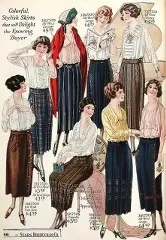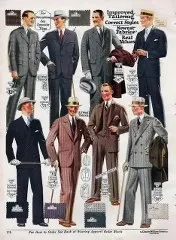The
current economic climate seems to have contributed to the trend of acquiring
and repurposing vintage clothing, accessories, and homeware products,
especially for younger consumers. The popularity of vintage has also been
linked to changing consumer attitudes towards wearing and using secondhand
goods. In addition to changes in attitudes, other factors contributing to the
growth of the vintage trend include changes in values, the incorporation of
vintage inspiration used in current designs by fashion designers and trends
marketed by the forecasting sector, eco-sustainability, media, and technology.
In addition, vintage consumers and vintage retailers appear to share a movement
toward vintage fashion that has been aided by a backlash against mass-produced
fast fashion, as consumers strive for more individuality in their styling and
clothing. Eco-fashion and sustainable fashion ideals have emerged as solutions
to environmental problems currently inherent in industrial production
processes, with government support. These ideals and practices complement the
phenomenon of vintage trends.
Vintage Fashion
Vintage
fashion is a general term for clothing originating from an era as recent as the
1990s. The term can also be applied to second-hand retail outlets. The concept
arose as a response to textile shortages during the First World War, choosing
vintage dressing accessories, mixing vintage clothing with new, and creating a
fusion of different styles and periods. Vintage clothes are usually sold at
lower prices for high-end name brands. Vintage fashion can be found in cities
at local boutiques or local charities, on the Internet, such as eBay and
Etsy, or through digital second-hand shopping websites. It has
seen a resurgence in popularity in the 21st century due to the increasing trend
of vintage pieces in the media and among celebrities, as well as consumer
interest in sustainability and slow fashion.
This fashion maintains and increases value because it is truly from a bygone era and
allows buyers to choose from a variety of styles from second-hand clothing.
Also, authentic garments are made one at a time, with enough attention to
detail to create an item that has lasting value. Vintage fashion can be
understood as a response to fast fashion, where clothes are mass-produced.
Vintage shopping allows customers to find unique pieces and create a sense of
individuality.
However, this fashion is often inaccessible and difficult to find. Fashion that
closely resembles original vintage fashion is mass-produced to meet consumer
demand for vintage fashion. An example of this is the slip dress that emerged
in the early 1990s, a style that resembles 1930s designs, but upon examination
reveals that it only resembles the real thing.
Vintage fashion history
The
concept of vintage fashion became popular during World War I due to textile
shortages. As a result, most clothing was either thrown away or recycled within
households as rags and quilts. During World War I, the United States launched a
conservation campaign with slogans such as "Make economy fashionable lest
it becomes obligatory." One result was an estimated 10% reduction in
wartime trash production.
The
most popular era is the 1930s to 1950s. This may be because most of the
respondents see these decades as the most synonymous with vintage. Earlier
decades are seen as more antique than vintage and later decades are seen as
retro or old-fashioned. Dresses, skirts, and accessories are the most
sought-after products. Although the reasons are not explored, accessories are
inexpensive to buy to bring out any vintage look. The most popular places to
buy vintage are vintage and charity shops, eBay, and secondhand shops.
During
the 20th and 21st centuries, vintage clothing grew in popularity throughout the
media and pop culture. The tide of popular fashion creates demand for constant
replacement of products with something new and fresh. Once known as secondhand
clothing, now seen as vintage fashion. This is due to increased visibility
through media, film, and television and the influence of celebrities. Over the
past 20 years, vintage fashion has been featured in leading fashion and
lifestyle magazines, including Marie Claire's 2011 publication. The popularity
of period pieces in film and television also contributed to the vintage fashion
trend. An authentic portrayal of 1960s fashion in the 2007 award-winning series
Mad Men led to a resurgence of glamor in consumer interest. This was reflected
in the prevalence of 1950s and 60s fashion on the 2010 runways and increased
sales in vintage shops. In the early 2000s, celebrities like Reese Witherspoon
and Renée Zellweger brought vintage clothing to the media by wearing vintage
pieces on the red carpet.
Vintage fashion description
Vintage
is a colloquialism, which is commonly used to refer to all old styles of
clothing. For vintage, a generally accepted industry standard is that items
made betn 20 to 100 years ago are considered vintage if they clearly
reflect the styles and trends of the era they represent. The fashion may also
be vintage if the brand name is not known. But if you know the brand but the
company logo doesn't match what they currently use, you may be discovering a
vintage product.
A
garment is probably vintage if it is handmade. If you notice that the edges
between a seam look like zigzag cuts, you can tell it's handmade. The edges
indicate that they were trimmed with pinking shears. Pinked seams, side
fasteners, and metal zippers were prominent elements of vintage fashion from
the late 1920s through the 1960s. In the 1950s, pinked seams were extremely
popular. The seams look like teeth and are supposed to prevent fraying. If the
seams don't have a finished look, you may have a dress made before the 50s.
Also, from the 1930s to the 1940s metal zippers were usually placed on the side
of a garment. On the other hand, after 1965 manufacturers used plastic zippers
in garments.
For
example, vintage fashion would be authentic clothing from a bygone era, while
retro fashion could be contemporary fashion made to reflect a particular
stylistic period, such as 80s fashion, or 90s fashion.
Vintage fashion brands
Vintage
fashions are undoubtedly a lot more fun and creative than the mass-produced and
conservative styles you'll find lining the shelves today. The quality of an
item from the 90's or 00's is much higher than today's offerings, and some of
the brands that make the list have made so many stunning outfits back in the
day, they truly deserve to be celebrated and kept in their fashion worn with
pride. These are as follows-
1.
Nike
2.
Adidas
3.
Reebok
4.
Tommy Hilfiger
5.
Champion
6.
YSL
7.
Ralph Lauren
8.
Fila
9.
Stone Island
10.
Lacoste
11.
Timberland
12.
Fred Perry
13.
Carhartt
Conclusion
Vintage
fashion is part of a larger movement of sustainable fashion and falls under the
category of slow fashion, which is a direct response to increasing awareness of
the environmental impact of the fast fashion industry. Over the past 10 years,
increased media coverage of environmental issues has increased consumer
interest in the use of ethical clothing and vintage fashion in particular. With
the rise of the virtual/digital world and social media, the consumption of
vintage fashion has expanded rapidly, with e-commerce websites leading to
increased consumer accessibility of vintage pieces. The Internet has greatly
increased the availability of specific and hard-to-find items and has opened up
potential markets for sellers around the world. Over the past 20 years, social
media in particular has become the most popular medium for consumers to obtain
information and communicate about vintage fashion.










0 Comments